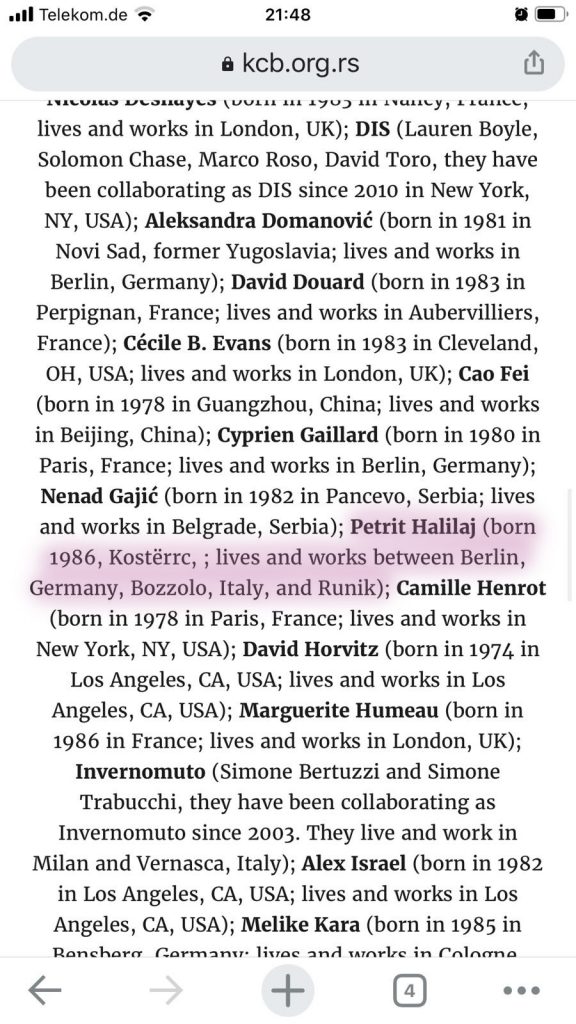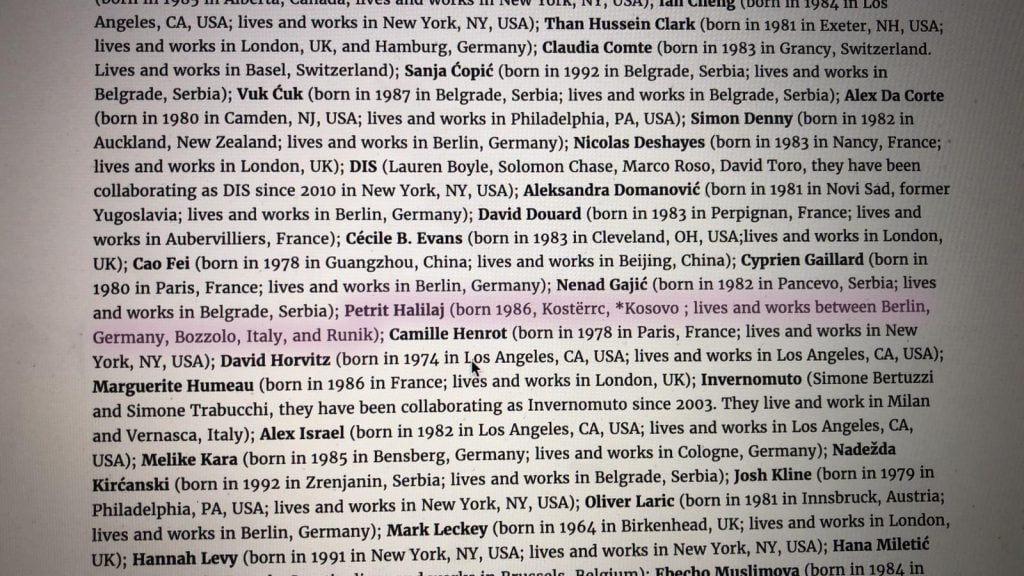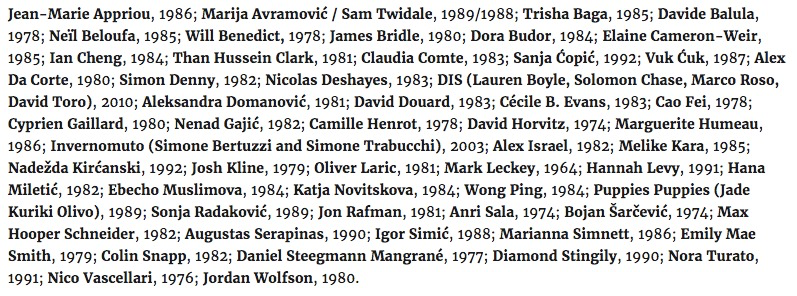The artist Petrit Halilaj has withdrawn from the Belgrade Biennial after the organizers of the exhibition dithered over how to present his nationality in accompanying materials.
Halilaj is from Kosovo, and the biennial is organized and hosted by the Cultural Centre of Belgrade in Serbia, a country that does not recognize Kosovo as an independent state. He pulled out of the show after he was unable to agree with the organizers about how his country of origin would be named in the list of participating artists.
Halilaj, who is based in Berlin, has written an open letter detailing his experience with the exhibition, which is officially called the 58th October Salon: Belgrade Biennial.
Kosovo declared independence from Serbia in 2008, and there is a fraught history between the two nations. During the Kosovo War of 1998–99, fought between the two nations, Halilaj himself was displaced and spent more than two years living in refugee camps. In his letter, Halilaj recalls how his and his family’s passports were destroyed, and refers to the conflict as a genocide.
“When I received the invitation to the Belgrade Biennial I was internally conflicted, but I also saw it as an opportunity to create a bridge, to open up a dialogue and to explore new paths of reconciliation through art,” Halilaj writes.
Curated by Ilaria Marotta and Andrea Baccin, this iteration was called “The Dreamers,” and Halilaj had planned to show a video called Shkrepetima (Flash of Light) resulting from a theater performance he staged in his home city of Runik in Kosovo, inside the ruins of the city’s House of Culture, which was destroyed during the conflict.
Organizers first omitted his country of origin from a document released in May. After he requested a correction, organizers introduced it with an asterisk, which Halilaj says “reiterates the refusal of Serbia to recognize Kosovo as an independent country.”
“The asterisk does not even begin to repair a century of oppression and genocide that Serbia has inflicted on Kosovo and it is painful to witness in the context of an art institution that may have a different understanding of the issue,” Halilaj writes.
Later, the institution ended up removing all mentions of the participating artists’ countries of origin, but Halilaj withdrew anyway out of fear that his work, which grapples with the plight of Kosovo’s multiethnic society, risked “being miscommunicated and misinterpreted, or even politically instrumentalized.”
The biennial is slated to open on October 16. Contacted by Artnet News, a spokesperson for the Cultural Center of Belgrade explained that as a public institution, it was obliged to follow Serbia’s official policy on Kosovo.
“As you know the official policy of the Republic of Serbia doesn’t recognize Kosovo as [an] independent country, so we as [a] public institution could not write [it] differently,” the spokesperson said.
“From the beginning of this unpleasant situation for Petrit Halilaj we were open for dialogue with the artist,” the show’s organizers said in a statement, adding that they hope he changes his mind and rejoins the exhibition.
They declined to elaborate on how they would deal with artists from Kosovo in the future.
Following Halilaj’s withdrawal, the organizers removed all cities and countries from the list of participating artists, which Halilaj says he hopes will be the biennial’s policy for future editions.
Read Halilaj’s open letter in full below.
GIVE US BACK OUR STARS
Petrit Halilaj’s withdrawal from The Dreamers, 58th Salon – Belgrade Biennial
Open letter
In 2019 I was invited by Ilaria Marotta and Andrea Baccin to take part in the 58th Salon – Belgrade Biennial, titled The Dreamers, organized and hosted by the Cultural Centre of Belgrade (KCB) and opening in October 2020. I was excited to collaborate with them and to travel to Belgrade for the first time as a Kosovar artist. I would exhibit the video resulting from Shkrepëtima, a theatre performance staged in Runik (the city where I grew up in Kosovo and the site of one of the earliest Neolithic settlements in the region) among the ruins of the Runik’s House of Culture—a symbol of the local multiethnic identity that has been closed down, emptied out and abandoned when the political situation with Serbia deteriorated in 1990’s. When we started the project, the House of Culture was in a state of extreme abandonment and deterioration; trash had also been dumped there for years. We created a community of more than 80 people and cleaned up the space to give it back its life and cultural voice in Runik. Shkrepëtima is dedicated to the dreams of the citizens in Runik and it seemed to resonate with the aim of The Dreamers.
As many may know, Serbia does not recognize Kosovo as an independent country yet. After having silenced Kosovo’s cultural expression and cut education, in 1998–1999 Serbia undertook an armed invasion in Kosovo and violently repressed the Kosovar Albanian community which I am part of. This oppression has been referred to as a genocide, and it has urged other countries to take a side; it still does it today, when Kosovo’s unilateral Declaration of Independence (2008) is partly met with encouragement, partly neglected. During all these years, Serbia has officially treated the repression of Kosovo as if it were a matter of fiction. As if it never happened.
It did happen. In 1998–1999, I was one of the many people forced to live as a refugee and in camps for over two years after our houses had been burned to the ground. I consider myself lucky to have survived. My passport and that of all my family members were destroyed in front of us and we were suddenly neglected both our freedom of movement and our identity. So when I received the invitation to the Belgrade Biennial I was internally conflicted, but I also saw it as an opportunity to create a bridge, to open up a dialogue and to explore new paths of reconciliation through art. I wanted to overcome the dichotomy between “us” and “them”, between “good” and “evil”, to finally open up a shared space of discussion instead of broadening a division that has already forged so much hatred. I had the optimistic expectation that an art institution would be a space capable to represent a plurality of identities, eventually even taking a stand beyond the official politics around my country of origin, by just calling it by its name: Kosovo. The concept of The Dreamers, as well as the curators’ intention to transcend national divisions with this project supported my hope. Unfortunately I was confronted with a radically different reality.
With this letter I want to leave a trace of what I experienced in the past months, and what led to my withdrawal in June. This is my side of the story, of course, and I know that there are other viewpoints that should also be taken into account. On my side, I am making this public because a silent withdrawal would add another layer of impotence to the silencing I have experienced during this process, to the silencing and erasing of memories and experiences that runs through history. Instead, I hope to generate some discussion on the limits of political agency in government-funded art institutions located in countries that are still pursuing nationalistic and oppressive politics; on the potential of dreaming at all through art practices when the exhibition space becomes a frame that outlines the limits of the artist’s identity, and therefore of the dream itself; and more broadly, on the current political situation between Serbia and Kosovo.
The story begins in the second half of May, with the publication of the artists list.

Screenshot of KCB website, May 25th, 2020.
When the artist list of The Dreamers was made public, Ilaria Marotta noticed that my nationality, Kosovo, had been omitted from KCB’s public communication. In the text, each artist was listed along with information regarding the year of birth, birthplace and country, as well as current living and working location. In my case, the name of the country was left blank after the comma, which—given the historic and current geopolitical context—I instinctively interpreted as an intentional omission of information. This omission had been decided by KCB independently from Ilaria and Andrea, with no previous notice, probably in the hope that no one would spot it or make a big deal about it.
As an artist, one imagines to be invited not because of nationality or place of birth, but rather for the ideas one aims to spread. This is why I would have agreed with this omission only if all the artists’ countries would have been omitted from the beginning, for example as a statement to explicitly transcend nation-state divides and to address their questionable relevance within an art project. On the contrary, like this, the omission of Kosovo from KCB’s website acquired a much broader meaning and could only be read through the lenses of a wider and systematic political silencing. In my dream world, I wish that people could move freely with no exception beyond geographical boundaries and cultural barriers, as I like to imagine birds do. But we are still far, very far, from anything close to the realization of this dream and I believe such omissions shouldn’t be left unnoticed, they have a political relevance that goes beyond my own experience, and speak of programmatic political and ideological interventions performed behind the scenes of art institutions.
This is not the first time that I have been invited to exhibit in a country that does not recognize Kosovo’s independence, but it is the first time that I feel the need to withdraw my work. My most recent project at the Palacio de Cristal, Museo Reina Sofía in Madrid, Spain, is also in a state-funded institution in a country that does not recognize Kosovo. However, in this case Kosovo appears. And even in the city of Belgrade, there are art spaces that write the name of Kosovo when a Kosovar artist is invited to exhibit their work.
I was aware that this omission did not respond to the curators’ direct will. I also understand that KCB may be actually composed of people with radically different political opinions, and that not all of them would agree with this state policy. But when do we have any agency? And if not, at what cost? For what cause? I discussed this with the curators to see this omission as an opportunity to open up a constructive dialogue around the issue of geopolitical recognition of countries that are still neglected zones on a global scale. The aim of The Dreamers is in fact “to investigate the complexity of the current times, questioning not only the misleading nature of the real, but the space occupied by dreams, intended as the metaphorical embodiment of a space of freedom, which is able to challenge the certainty of the real world, of acquired knowledge and of our own beliefs.” Accepting the omission of Kosovo, however, would have been a powerless surrender rather than the hopeful construction of a space of freedom. In the act of agreeing to this omission (which would have also meant to come to terms with being treated differently), I saw an indirect acceptance of the structural lack of free political opinion or agency in this art institution, which for me was in direct contrast with the initial aim of the show.
After my request to include Kosovo, KCB replied first by assuring that it had been a typo, then modifying it several times until adding Kosovo with an asterisk (*Kosovo.)
On KCB’s website, the asterisk in *Kosovo seemed to be linked to the footnote “In 2018, Board of the 57th October Salon made a decision to add the subtitle Belgrade Biennale to the name October Salon in the future.” As an apparently harmless sign, it gives the impression of really being a typo; of having been wrongly slipped into the text and linked to something unrelated. It could have easily gone unnoticed.

Screenshot of KCB website, June 8th, 2020.
But the asterisk in *Kosovo is charged with strong political implications that were disguised on the website. * is the result of a 2012 agreement to allow Kosovo to represent its institutions without the authority of the UN Mission (until then, Kosovo was written as Kosovo-UNMIK). This asterisk only enables representatives from Kosovo to be referenced in regional meetings and in agreements with a footnote declaring that “This designation is without prejudice to positions on status, and is in line with UNSCR 1244 and the ICJ Opinion on the Kosovo Declaration of Independence”. This asterisk is a declaration of “status-neutrality” and it reiterates the refusal of Serbia to recognize Kosovo as an independent country. The asterisk does not even begin to repair a century of oppression and genocide that Serbia has inflicted on Kosovo and it is painful to witness in the context of an art institution that may have a different understanding of the issue.
During this process I learned that the cultural centre had been negotiating with the Minister of Foreign Affairs for the addition of Kosovo and the modification of the total number of participating countries. The time in between these modifications gave me the opportunity to think and to observe how unprepared we all were to face issues like these, but also to reflect upon and learn how to deal with them.
I want to believe that art has a transformative potential. This belief is also among the reasons why I devoted my life to it. But this experience begs the questions: What is the actual ability to dream of art institutions and what is the space they are willing to give artists to dream? And if artists are given a specific frame for their dreams, a frame that is outlined and monitored by the dominant power and politics, then how far can we go?
In an attempt to find a neutral solution and facing the impossibility of adding Kosovo, KCB modified the website again by deleting all the countries of all the artists participating, and leaving the cities only. They said this was as far as they could go.

Screenshot of KCB website, June 12th, 2020.
Nevertheless, I felt that a withdrawal of Shkrepëtima was necessary, and that an open letter could potentially be a better tool for discussion in a context where an artwork undergoes the risk of being miscommunicated and misinterpreted, or even politically instrumentalized beyond the power and intentions of the curators of The Dreamers or the direction of KCB.
Only after my withdrawal, KCB and the curators of this edition of the Belgrade Biennial decided to delete from the public communication all the names of the cities and countries involved, leaving only the artists’ year of birth. This sign left by my withdrawal has created an antecedent for the next edition, and I hope it will have a resonance beyond the regional context of Serbia and Kosovo.

Screenshot of KCB website, June 24th, 2020.
This letter is the result of weeks of exchanges, brainstormings and discussions with collaborators, colleagues, peers and friends, all of whom I am very grateful to. I am especially grateful to David Horvitz who will take part in the Belgrade Biennial and has proposed to modify his work “Give Us Back Our Stars” after my withdrawal. In this gesture, I see an important sign of solidarity and healing. One of those signs that give hope, and make one dream.
Follow artnet News on Facebook:
Want to stay ahead of the art world? Subscribe to our newsletter to get the breaking news, eye-opening interviews, and incisive critical takes that drive the conversation forward.
"artist" - Google News
July 29, 2020 at 12:57AM
https://ift.tt/2DaQlnI
Artist Petrit Halilaj Has Pulled Out of the Belgrade Biennial After Its Organizers Refused to Recognize His Nationality - artnet News
"artist" - Google News
https://ift.tt/2FwLdIu
Bagikan Berita Ini














0 Response to "Artist Petrit Halilaj Has Pulled Out of the Belgrade Biennial After Its Organizers Refused to Recognize His Nationality - artnet News"
Post a Comment